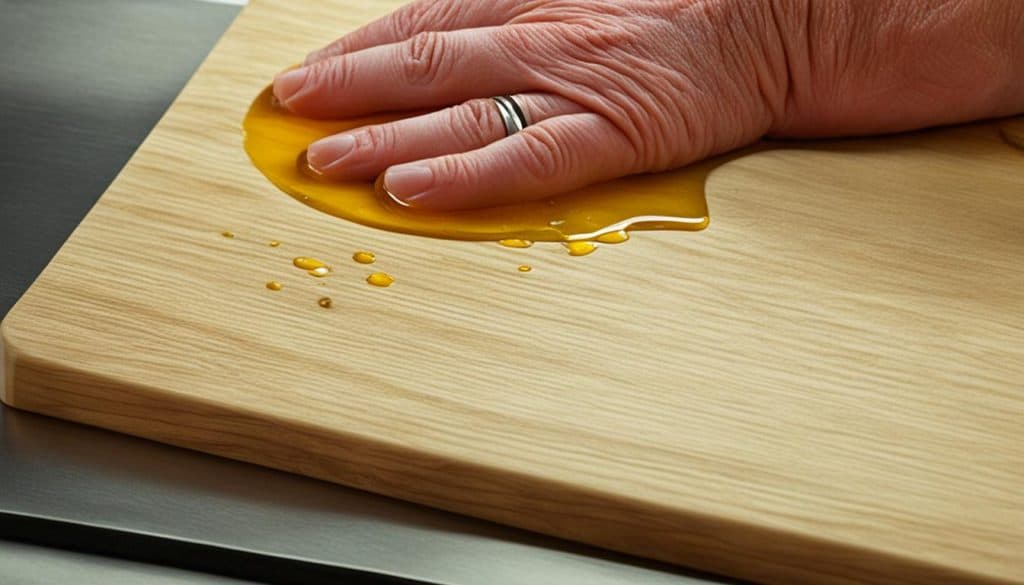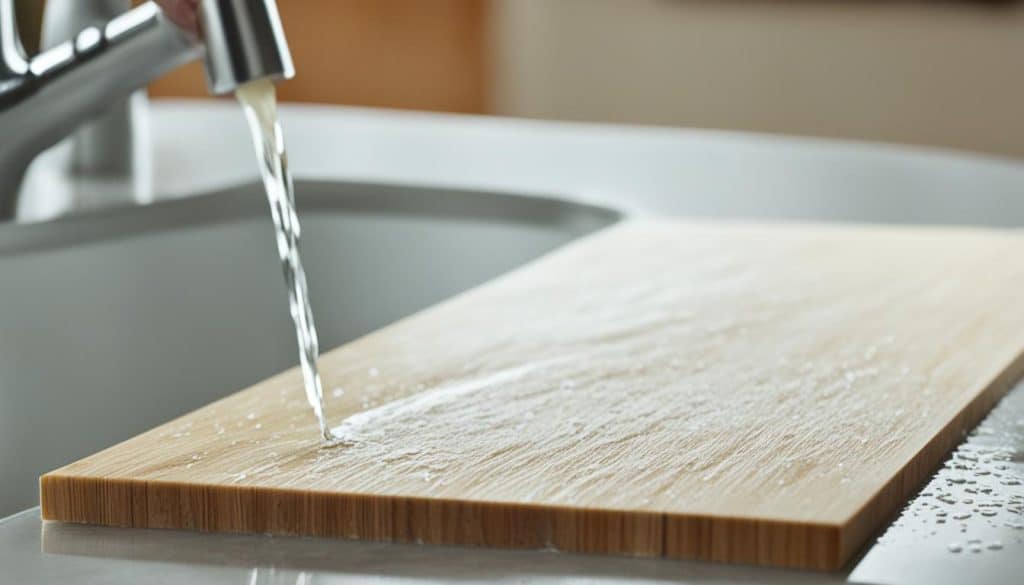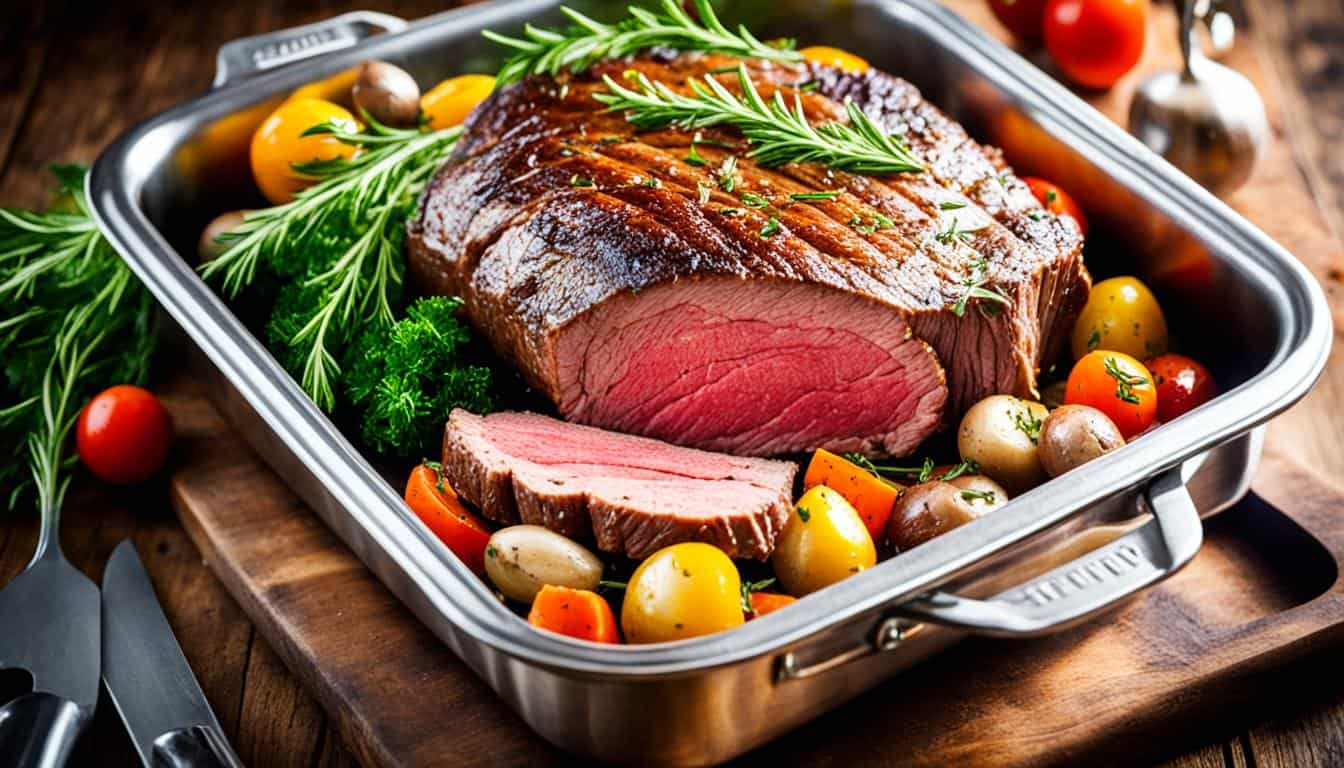A good cutting board is key in every kitchen. It helps with chopping veggies, meat, or fruit. But picking the right one can be tough. How do you know which one to choose?
Let me share a story that might help you understand the importance of choosing and caring for your cutting boards:
Meet Sarah, a passionate home cook who loved making meals for her family. One evening, she was in a rush and chopped veggies on her old plastic cutting board. She didn’t notice the tiny grooves and cuts that were perfect for bacteria.
The next day, Sarah’s family got food poisoning. She was worried and wanted to find out why. After talking to cleaning experts, she learned her cutting board wasn’t clean enough. This caused cross-contamination.
This event taught Sarah a big lesson. She learned that the type of cutting board and how you take care of it are key to keeping food safe. She now wants to share this knowledge with others to keep kitchens safe and clean.
In this article, I’ll help you pick the right cutting board for you. I’ll also give tips on how to take care of them properly.
Key Takeaways:
- Cleaning cutting boards after each use is essential to prevent cross-contamination.
- Sanitize cutting boards at least once a week, or more frequently if heavily used.
- Recommended sanitizing agents include baking soda, distilled white vinegar, hydrogen peroxide, and diluted bleach.
- Avoid abrasive scouring pads that can damage wooden cutting boards.
- Dry cutting boards thoroughly after washing to prevent mold and bacterial contamination.
Understanding the Importance of Proper Care
Keeping your cutting boards in good shape is key for their longevity and food safety. By following simple steps, you can make your cutting board last longer, stop bacteria from growing, and keep it working well.
Think about the type of cutting board you own. End-grain cutting boards are known for their beauty and can fix cuts by closing their fibers. But, they need extra care to avoid warping and cracking because they’re sensitive to moisture.
Edge-grain cutting boards, made from long planks, have grains that run parallel to the counter. They’re good at handling moisture but still need the right care to stay in good shape.
It’s a good idea to use different cutting boards for different foods to avoid mixing bacteria. This helps prevent bacteria from moving from raw meats, poultry, seafood, and foods like bread and fruits.
When cleaning, hot, soapy water, bleach solution, or undiluted vinegar all work well to kill bacteria on cutting boards. The USDA suggests a bleach solution of 1 tablespoon per gallon of water for cleaning. Let it sit for 2-5 minutes to kill all bacteria.
Regular care keeps your cutting board in great shape. Treat wood cutting boards with food-grade mineral oil every month to stop them from drying out and cracking. Using beeswax and oil wood conditioners can also protect against water and keep water away.
To get rid of smells, try scrubbing your cutting board with salt and lemon every three months. This method gets rid of bad smells and keeps your board smelling fresh.
Image: Cutting Board Care and Maintenance

If your cutting board gets a fuzzy texture from lifted wood fibers, sand it with sandpaper (grit of 220 or higher). This will make the surface smooth again and improve how it looks and works.
Avoid using wood cutting boards as trivets because the heat can damage the glue. Also, store your cutting board right to prevent it from warping or cracking.
The USDA likes bamboo cutting boards because they’re hard and don’t absorb much moisture. This makes them easy to clean and keep up.
Wooden cutting boards can cost from $25 to $150 or more, based on quality and craftsmanship. Remember, wooden boards are safer than plastic ones because they don’t hold bacteria. With the right care, a wooden cutting board can last 5 to 10 years or more. Plastic boards, on the other hand, may need replacing every year or two.
In summary, taking good care of your cutting board is key for its long life and keeping food safe. By cleaning it right, oiling or waxing it, and storing it properly, you can have a clean, safe, and long-lasting cutting board.
The Anatomy of a Wood Cutting Board
Wood cutting boards are essential in every kitchen. They are made with sustainability and longevity in mind. 65% of chefs prefer them for their durability and looks. Unlike plastic boards, wood absorbs juices, preventing contamination and ensuring food safety.
The type of wood affects the board’s durability and looks. Hardwoods like maple, oak, and walnut are top choices for their strength and beauty. These woods can handle heavy use and knife cuts well. They also add a stylish look to any kitchen with their natural grain patterns and colors.
Wood cutting boards have a natural antibacterial effect. Studies show they kill bacteria faster than plastic boards. The wood traps bacteria under its surface, where it dies off. This makes wood boards safer for food prep, reducing the risk of contamination and illness.

Looking at a wood cutting board, you’ll see it’s built to last. Sizes vary, but they’re usually 10 to 15 inches wide and 14 to 20 inches long. They offer a good work area while being easy to handle and store.
Wooden cutting boards need more care than other types. Use food-grade mineral oil or cutting board oil to keep them looking good and working well. Waxing with beeswax or carnauba wax adds extra protection and highlights the wood’s beauty.
To keep a wood cutting board in top shape, follow some simple care tips. Don’t soak it in water or put it in the dishwasher, as this can cause damage. Clean it with vinegar and water or salt and lemon. Oil and wax it regularly, and store it upright or on its side to keep it in great condition.
Wood cutting boards are a must-have for any kitchen. They’re functional, beautiful, and have antibacterial properties. They’re a great choice for home chefs everywhere.
Daily Cleaning and Maintenance
Keeping your cutting board clean is key for food safety and its life span. By cleaning it every day, your cutting board will stay in great shape for many years.
Start by rinsing your cutting board with hot water to get rid of food bits. Next, use a sponge or cloth with soap and water to clean it well. Make sure to rinse it again and let it dry before putting it away.
Soap and Water
Soap and water are top choices for cleaning your cutting board. They get rid of food bits and kill bacteria, making your board safe and clean. Adding this easy step to your daily routine keeps your cutting board clean.
Vinegar and Water
If you like natural cleaners, try vinegar and water on your wooden cutting board. Mix them in a spray bottle and spray on the board. Let it sit, then wipe it down with a damp cloth. Vinegar also fights odors and adds extra cleanliness.
Bleach and Water
If your cutting board touched raw poultry or meat, you might need to use bleach. Mix two teaspoons of bleach with a gallon of water to create a cleaning solution. Scrub the board well, making sure all parts are covered. Then, rinse it and let it dry completely.
Never put a wooden cutting board in the dishwasher, as it can cause damage. Always follow the right cleaning steps to keep your cutting board in good shape and make it last longer.
Next, we’ll look at how to keep your cutting board in top condition.
Routine Maintenance for Dryness and Sanitation
Caring for your cutting board is key. It keeps it safe and hygienic for food prep. At CuttingBoard.com, we often get asked, “How do I maintain my cutting board?” Let’s explore the best ways to keep your cutting board in great shape.
Sanitizing for a Clean and Safe Surface
Sanitizing your cutting board is vital to kill bacteria and germs. Start by cleaning it with mild dish soap and hot water. Make sure to clean all sides and crevices well. Then, rinse off any soap left behind.
For extra cleanliness, use vinegar or lemon juice. These natural cleaners kill bacteria and get rid of odors. Just spread a bit of vinegar or lemon juice on the board, let it sit, and rinse with hot water to clean off any leftovers.
Treating and Oiling for Longevity
Dryness can cause cutting boards to crack and warp. To stop this, treat your board with food-grade mineral oil often. This oil keeps the wood moist and protected.
First, clean your cutting board and let it dry. Then, apply food-grade mineral oil all over the board. Use a cloth or paper towel to spread it evenly. Let the oil soak in for a few hours or overnight, then wipe off any extra. Oiling your board once a month is a good rule of thumb for keeping it safe.
Removing Odors and Stains
Your cutting board might get smelly or stained over time. But, there are easy ways to fix this. Baking soda is great for getting rid of bad smells. Just sprinkle some on the board, spread it around, and scrub it with a damp cloth. Then, rinse with hot water.
For tough stains, lemon juice works well. Put some lemon juice on the stain, wait a bit, and scrub it with a cloth. Rinse with hot water to get rid of any lemon smell.

By following these steps, your cutting board will stay in great shape for a long time. Remember, taking good care of your board is key for its warranty. John Boos & Co. won’t cover warranties if boards aren’t properly maintained or oiled each month. So, always sanitize, oil, and clean your board to keep it in top condition.
Monthly Care: Oil and Wax
Keeping your wooden cutting board in top shape is key. Using oil and wax regularly keeps the wood from drying out and cracking. By picking the right products and sticking to a routine, your cutting board will last for many years.
How often you oil your cutting board depends on how much you use it. If you use it every day, oil it once a month. This keeps the wood moist and strong. If you use it less often, oil it 2-3 times a year to keep it in good shape.
The Howard Butcher Block Conditioner and Cutting Board Oil is a great choice. It’s a food-safe oil made in the USA from pure USP grade white mineral oil. It deeply hydrates and protects the wood, making your cutting board last longer.
Waxing your cutting board now and then is also a good idea. The Boos Butcher Block Board Cream is perfect for this. It’s made from unbleached beeswax and food grade mineral oil. This wax creates a protective layer that makes your wooden items last longer. Using wax and oil together keeps your cutting board in great shape for everyday use.
In short, taking care of your cutting board every month means oiling and waxing it. This keeps the wood in good condition. Products like the Howard Butcher Block Conditioner and Cutting Board Oil, and the Boos Butcher Block Board Cream, are great for this. Adding these to your routine will keep your cutting board looking great for years.
Proper Cleaning Techniques
Keeping your cutting board clean is key. It doesn’t matter if it’s wooden, plastic, or bamboo. The right cleaning steps will keep it clean, last longer, and stay hygienic.
Wooden cutting boards should not go in the dishwasher. The heat and detergents can harm them. Instead, wash them by hand with mild soap and warm water. This keeps the wood from splitting or warping.
Plastic cutting boards can go in the dishwasher, but washing them by hand is better if you can. This keeps their quality up and avoids any dishwasher damage.
No matter the cutting board type, clean it with soap, water, and a soft sponge. This gets rid of food bits and bacteria.
Disinfecting After Raw Meat Contact
After touching raw meat, clean your cutting board to stop germs from spreading. Here are ways to do it:
– White vinegar: Use white vinegar to kill bacteria. Let it sit a bit before rinsing.
– Diluted bleach: Mix 1 tablespoon of bleach with a gallon of water. Apply it, wait a few minutes, then rinse well.
– Hydrogen peroxide: Put hydrogen peroxide on the board, wait a bit, then rinse.
These methods kill germs and make your cutting board safe again.
Removing Stains
For stains on your cutting board, try these natural ways to get rid of them:
– Baking soda: Put baking soda on the stain and scrub with a soft sponge or cloth.
– Coarse salt and lemon: Rub the stained area with a lemon half dipped in coarse salt.
These methods will clean your cutting board and remove stains.
Proper cleaning and care are crucial for your cutting board’s life and hygiene. By following these steps, your cutting board will stay in great shape for a long time.
Tips for Storage and Maintenance
Proper storage and maintenance are key to keeping your cutting board in good shape. Here are some tips to help your cutting board last longer:
1. Storage: Keep your cutting board in a cool, dry spot to avoid moisture. Don’t stack boards or store them flat, as this can cause mold. Use vertical dowels in your pantry or cabinets to keep boards safe and easy to reach.
2. Repairing Defects: Check your cutting board often for cracks or splits. These can make the board less durable and let bacteria hide. Fix any defects quickly or get a new board if needed.
3. Maintenance: Clean your cutting board right, based on its type. Wooden boards need to stay dry and should be oiled with safe oils. Clean them with mild soap and warm water after each use. Plastic boards should be color-coded to avoid mixing foods. Watch for bacteria in deep grooves.
By storing your cutting board right, fixing any damage fast, and keeping it clean, you’ll make it last longer. This ensures safe and clean food prep.


